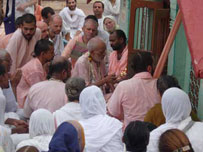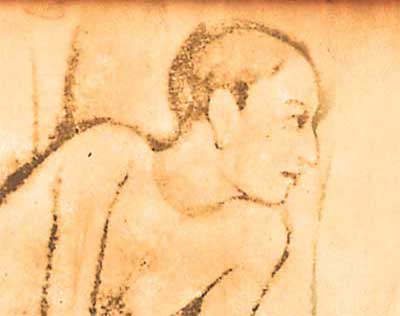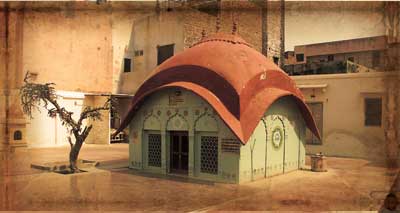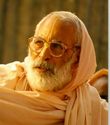

Vrndavana, India: August 17, 2005
At 6:30 am, on Srila Rupa Gosvami's Disappearance Day, Srila Narayana Maharaja took about two-hundred devotees to Sri Rupa-Sanatana Gaudiya Matha for darsana of Sri Sri Radha-Vinodabihari. Along with all those devotees in the form of a kirtana party, he then went to Sri Radha-Damodara temple. Everyone present circumambulated the temple, first visiting the samadhis of Srila Jiva Gosvami and Srila Krsnadasa Kaviraja Gosvami, and then, led by Srila Maharaja, offering arati at the puspa-samadhi of Srila Bhaktisiddhanta Sarasvati Thakura while singing Sri Prabhupada-Padma Stava.
After that, they all went to the samadhi of Srila Rupa Gosvami, where Srila Maharaja led them in the performance of arati and then showered them with the nectarean glorification of Rupa Gosvami and his unique contribution. After that, Srila Maharaja led them in worship of Rupa Gosvami's place of bhajana.
In the evening there were about four hundred devotees present at Sri Rupa-Sanatana Gaudiya Matha. Srila Narayana Maharaja had invited a panel of Mathura devotee-scholars, and after they each glorified Rupa Gosvami, Srila Narayana Maharaja himself spoke.
Srila Maharaja expressed his appreciation of the wisdom shared by the various speakers, and he illuminated their main points. He especially appreciated Bhuti Krsna Gosvami's explanation. Simultaneously summarizing and expanding on the Gosvami's words, Srila Maharaja explained that all the commentaries and writings of Srila Raghunatha dasa Gosvami, Srila Krsnadasa Kaviraja Gosvami and Srila Visvanatha Cakravarti Thakura were all manifest by Srila Rupa Gosvami's mercy. Srila Krsnadasa Kaviraja Gosvami gave us Radha-Krsna's asta-kaliya-lila (daily pastimes) in the form of Govinda-lilamrta, and Srila Visvanatha Cakravarti Thakura gave it in the form of Sri Krsna-bhavanamrta. All of their work was inspired by Srila Rupa Gosvami, in whom they took shelter.
Srila Maharaja explained how Srila Rupa Gosvami gave Srila Raghunatha dasa Gosvami Radha and Krsna's tax pastimes in the form of his book, Dan-keli-kaumudi, and that inspired Srila Raghunatha dasa Gosvami to write his own Dan-keli-cintamani.
Whatever Srila Visvanatha Cakravarti Thakura wrote was inspired by Srila Rupa Gosvami. He wrote the commentary of Srila Rupa Gosvami's Bhakti-rasamrta sindhu in the form of his Bhakti-rasamrta-sindhu-bindhu. He wrote Prema-samput and Camatkara-candrika. Without Srila Rupa Gosvami, the other acarayas could not have given the world what they did. Sri Krsnacandra and Srimati Radhika are merciful, and Lalita and Visakha are merciful, but without Srila Rupa Gosvami's mercy we would not be able to get their mercy. Without Srila Rupa Gosvami, no one would have known what Sri Caitanya Mahaprabhu came to give, and what He came to taste madanakya-mahabhava. Our entire disciplic succession is coming from Srila Rupa Gosvami, and the entire universe gets from him the root of all moods and philosophy of bhakti-rasa.
Srila Narayana Maharaja then glorified the discussion of Vasudeva Krsna Caturvedi, and expanded on one of Caturvedi's important points his expression of Sri Vithalacarya's song, Sri Radha-prarthana.
Srila Maharaja quoted the song and explained its verses. He began with the first words: Krpayati yadi radha
krpayati yadi radha badhitasesa-badhaSrila Maharaja then began his glorification of the song: Where did Sri Vithilacarya get this idea? He got it from his association with Srila Raghunatha dasa Gosvami, who received his ultimate realizations from Srila Rupa Gosvami.
kim apara-visistam pusti-maryadayor me
yadi vadati ca kincit smera-hasodita-srir
dvija-vara-mani-panktya mukti-suktya tada kim (1)[If Srimati Radhika is merciful to me, then all obstacles to my devotion will be removed. There will be nothing more for me to attain because I will have received the fruits offered by the paths of both vaidhi-marga and raga-marga. And if She will speak to me while smiling gently, I will see Her brilliant rows of teeth which are like lines of priceless jewels. Having seen them one time, the goal of gaining liberation from material existence will be rendered insignificant.
(Sri Radha-Prarthana, verse 1)]
syamasundara sikhanda-sekharaSrila Maharaja continued: We are so fortunate, because now Srila Rupa Gosvami's disciplic succession is here and we have come to it.
smera-hasa murali-manohara
radhika-rasika mah krpa-nidhe
sva-priya-carana-kinkarim kuru[O Syamasundara! O Sikhanda-sekhara (whose head is adorned with peacock feathers)! Your face is always graced with a playful smile, Your flute-playing is enchanting, and You are so expert in relishing rasa with Srimati Radhika. Because You are an ocean of mercy, I am appealing to You to please make me a kinkari (maidservant) at the feet of Your beloved.
(Sri Radha-Prathana, verse 2)]
Srila Rupa Gosvami has given us Sri Upadesamrta. From there we learn not to criticize. We learn to only criticize our own mind.
krsneti yasya giri tam manasadriyetaWe should surrender our entire lives to one who is ninda-sunya, who never commits any offenses. This is all explained by Srila Rupa Gosvami, whose culmination verse in this book is:
diksasti cet pranatibhis ca bhajantam isam
susrusaya bhajana-vijnam ananyam anya-
nindadi-sunya-hrdam ipsita-sanga-labdhya[One should mentally honor the devotee who chants the holy name of Lord Krsna, one should offer humble obeisances to the devotee who has undergone spiritual initiation and is engaged in worshiping the Deity, and one should associate with and faithfully serve that Pure devotee who is advanced in undeviated devotional service and whose heart is completely devoid of the propensity to criticize others.
(Upadesamrta, verse 5)]
tan-nama-rupa-caritadi-sukirtananu-All Gaudiya acaryas fall at Srila Rupa Gosvami's lotus feet and take shelter there. I pray to his lotus feet that he will give all of you his mercy.
smrtyoh kramena rasana-manasi niyojya
tisthan vraje tad-anuragi jananugami
kalam nayed akhilam ity upadesa-saram[The essence of all advice is that one should utilize one's full time-twenty-four hours a day-in nicely chanting and remembering the Lord's divine name, transcendental form, qualities and eternal pastimes, thereby gradually engaging one's tongue and mind. In this way one should reside in Vraja and serve Krsna under the guidance of devotees. One should follow in the footsteps of the Lord's beloved devotees, who are deeply attached to His devotional service.
(Upadesamrta, verse 8)]
Tomorrow is Baladeva Purnima, and we will meet again. My thanks to all who have come here.


[Vrndavana, India; August 17, 2005 (am)
This discourse was given in front of Srila Rupa Gosvamis samadhi at Sri Radha-Damodara Mandira]
Today we are very fortunate to be here at the bhajana-sthali and samadhi-sthali (sthali means place) of Srila Rupa Gosvami, here at Sri Radha-Damodara Temple.
Srila Rupa Gosvami is the life of the Gaudiya Vaisnavas. He is the crest-jewel of the rasika-bhaktas (devotees who taste transcendental mellows) and it is he alone who fulfills the mano-bhistham, the heartfelt desire, of Sri Caitanya Mahaprabhu. We have performed our worship of him, and we pray to his lotus feet that his conceptions may manifest in our heart. We pray that the manner in which he served Sri Gauranga Mahaprabhu and Sri Sri Radha-Krsna may also manifest in our heart.
If Srila Rupa Gosvami had not come to this world, the flood of mercy created by Sri Caitanya Mahaprabhu the gift of service to Srimati Radhika would have stopped when the Lord disappeared. Sri Krsna came to this world as Sri Caitanya Mahaprabhu for two reasons. The first reason was to taste His three unfulfilled desires. *[See Endnote 1] The second reason was to distribute to the world the path of spontaneous devotion (raga-marga) following in the wake of Sri Krsna's Vrndavana associates), and especially the service of Srimati Radhika. Sriman Mahaprabhu manifested in the heart of Sri Rupa Gosvami and inspired him to write all his transcendental literatures, especially Bhakti-rasamrta Sindhu, Ujjvala Nilamani and later Vidagdha-madhava.
Before Sri Caitanya Mahaprabhu appeared here, people hated parakiya-rasa. They had a bad idea about it. Even other sampradayas like the Sri (Laxmi) Sampradaya of Srila Ramanujacarya and also the Nimbarka sampradaya were against the worship of Radha-Krsna to such a degree that they separated the Deity of Radha from the Deity of Govinda in Jaipur.
Srila Rupa Gosvami established the true conception of Sri Caitanya Mahaprabhu by his books. He especially used the Srimad-Bhagavatam as evidence to establish that parakiya-rasa is not only bona fide, but is the highest expression of devotion. He established this truth in such a strong way that all the other sampradayas had to bow their heads and accept it.
What would have happened if Srila Rupa Gosvami had not appeared in this world?
Vraja-prema the prema of the dasya, sakhya, vatsalya, and especially the prema of the gopis was contained in a storehouse. There are so many types of gopi-bhava, namely sneha, mana, pranaya, raga, anuraga, bhava, mahabhava. All these definitions were given by Srila Rupa Gosvamipada.
The "definition" verse of Srimad-Bhagavatam contains its essence:
ete camsa-kalah pumsahBut Srila Rupa Gosvami showed us how to obtain that Supreme Lord of all, by giving definitions for all the stages of devotion to Him. What is sneha? What is maan? What is pranaya? What is raga? What is anuraga? What is bhava? What is madana-bhava? What is madanakya mahabhava? *[See Endnote 2] He gave definitions for sraddha, nistha, ruci, suddha-sattva and bhava bhakti. *[See Endnote 3] He manifested the definition of sadhana bhakti:
krsnas tu bhagavan svayam["All of the above-mentioned incarnations are either plenary portions or portions of the plenary portions of the Lord, but Lord Sri Krsna is the original Personality of Godhead." (Srimad Bhagavatam, 1.3.28)]
krti-sadhya bhavet sadhya-Srila Rupa Gosvami explained that sadhana is only sadhana when our goal is the attainment of bhava-bhakti. Then it can be called sadhana-bhakti; otherwise it cannot. Otherwise ones practice is called sadhana-abhasa (a shadow or semblance of devotional practice). He gave us the definitions of prema and he showed the entire world the nature of Srimati Radharani's attraction to Krsna. He showed the world how we can be attracted to Radha and Krsna. He taught the identity of Radha-Krsna, and also that of Sri Caitanya Mahaprabhu:
bhava sa sadhanabhidha
nitya-siddhasya bhavasya
prakatyam hrdi sadhyata["When transcendental devotional service, by which love for Krsna is attained, is executed by the senses, it is called sadhana-bhakti, or the regulative discharge of devotional service. Such devotion eternally exists within the heart of every living entity. The awakening of this eternal devotion is the potentiality of devotional service in practice."
(Sri Caitanya Caritamrta, Madhya-lila 22.105)]
anarpita-carim cirat karunayavatirnah kalauWho is Sri Caitanya Mahaprabhu? Radha-bhava-dyuti-suvalitam naumi krsna-svarupam. He is Sri Krsna, covered by the complexion and bhava of Srimati Radhika. He came to this world to distribute Her service in this world. Who described the identity of Caitanya Mahaprabhu? Svarupa Damodara did not, Sarvabhauma Bhattacarya did not, and Sri Ramananda Raya did not. All knew, but when Sri Ramananda Raya began to explain His identity, Mahaprabhu closed his mouth. Only Rupa Gosvami could completely describe it. All others were checked, but Rupa Gosvami could not be checked. Mahaprabhu chose him to reveal Himself to this world, and also chose him to distribute the service of Srimati Radhika to the world. Rupa Gosvami had a special mood, and those who follow in his footsteps are called rupanugas. All rupanugas are raganugas, but not all followers of path of raganuga-bhakti are rupanugas.
samarpayitum unnatojjvala-rasam sva-bhakti-sriyam
harih purata-sundara-dyuti-kadamba-sandipitah
sada hrdaya-kandare sphuratu vah saci-nandanah["May the Supreme Lord who is known as the son of Srimati Saci-devi be transcendentally situated in the innermost chambers of your heart. Resplendent with the radiance of molten gold, He has appeared in the Age of Kali by His causeless mercy to bestow what no incarnation has ever offered before: the most sublime and radiant mellow of devotional service, the mellow of conjugal love."
(Sri Caitanya Caritamrta, Adi-lila 1.4)]
Sri Rupa Gosvami described bhakti, pure devotional service, in one verse:
anyabhilasita-sunyamIn the first two lines he showed us what is not bhakti. He also gave the words and explained the meaning of the words aropa-siddha bhakti, sanga-siddha bhakti, karma-misra bhakti, yoga-misra bhakti, anyabhilasita-yukta bhakti (bhakti covered by material designations) and so on. He described all these topics.
jnana-karmady-anavrtam
anukulyena krsnanu-
silanam bhaktir uttama["One should render transcendental loving service to the Supreme Lord Krsna favorably and without desire for material profit or gain through fruitive activities or philosophical speculation. That is called pure devotional service."
(Bhakti-rasamrta Sindhu 1.1.11)]
"If Srila Rupa Gosvami had not appeared in Kali-yuga, who would have opened the great store-house of vraja-prema and distributed its contents freely? Just as a swan separates milk from water, who else could have separated the rasas to taste them? Abandoning everything, he performed bhajana in Vrndavana and wrote his rasika literatures. He lived like a bee taking the nectar of lotuses who could have understood the nectar he was collecting? Who could have understood Krsna's pastimes in Mathura and Vrndavana? How could we have known the sweet vraja-lilas and the love between Radha and Madhava (another name of Sri Krsna, meaning the husband or beloved of the supreme Goddess of Fortune)? By the mercy of his lotus feet, all can sing about and attain such divine bliss. The surrendered Madhava dasa is always praying to embrace Sri Rupa's glories." (Yan Kali Rupa Sarira Na Dharata, by Sri Madhava dasa)]
The kirtana "Yan Kali Rupa Sarira Na Dharata" by Sri Madhava dasa states: "Just like a swan separates milk from water, in the same way Srila Rupa Gosvami separated the milk of suddha-bhakti (pure devotion) from the water of all different types of mixed bhakti.
Srila Rupa Gosvami left everything all his family members, his position, his disciples and so on. He came alone to Vrndavana.
Here, at Sri Radha-Damodara Mandira, he completed most of his books. He began to write a drama describing the pastimes of Krsna, but on the way to Jagannatha Puri, at Sri Satyabhama Pura, Satyabhama devi appeared in his dream and said, "Oh Rupa, you should write two dramas." Afterwards, in Puri, Mahaprabhu said to him, "Don't take Krsna out of Vrndavana. You should write two dramas Vidagdha-Madhava and Lalita-Madhava."
Satyabhama would not have appeared to an ordinary person. Radhika would not appear to an ordinary person. When Srila Rupa Gosvami heard the instructions of Mahaprabhu: "Don't take Krsna out of Vrndavana," he could understand that Satyabhama's intention and Mahaprabhu's intention were the same. So he wrote two dramas.
He wrote and compiled more than 30 books, such as Stava-mala and many others, and most were completed here at the Radha-Damodara temple.
There may be many different types of flowers, such as bheli, cameli, lotus, and so on, but unless there is a bee present, who can understand the nectar contained within those flowers? In the daytime, the bee goes to the lotus flowers. At night that lotus closes with the bee within it. That same bee, who is able to cut his way even through bamboo, cannot escape from the petals of the lotus. In the same way, all the gopis have very fragrant moods in the service of Krsna, but unless the bee is there, how we can understand their fragrance? As the bee is trapped by the lotus flower, the bee-like Krsna is trapped by the prema of the gopis. He is completely bound.
The words "ko janata, mathura vrndavana" are significant in this song. Without the mercy of Srila Rupa Gosvami, who would be able to understand what is Mathura and what is Vrndavana? Mathura is the place of aisvarya-mayi bhakti, and Vrndavana is the place of madhurya-mayi bhakti. Mathura and Vrndavana are so close, but no one from Mathura visits Vrndavana, and no one from Vrndavana visits Mathura. This is because, even though they are close in geography, they are very far in mood. This was all shown by the evidence of Srimati Radhika, who never went to Mathura.
"Ko janata vraja-nita." Without Srila Rupa Gosvami, who could understand the mood of Vrndavana or the behavior of the Vrajavasis? Without him, how could we have understood the attachment of Radhika and Madhava for each other? Srimati Radhika uses apparently very abusive language toward Krsna, but Her prema is actually millions of times greater than anyone elses. Her prema is greater than the sadharani-rati of Kubja. Her prema is greater than the samanjasa-rati of the queens of Dvaraka. The prema of Radharani and the gopis of Vrndavana is called samartha-rati. Samartha means that they can do anything in order to please Krsna, and therefore only their prema can completely satisfy and control Him. Without the mercy of Rupa Gosvami, who could understand that Krsna is only bound by Srimati Radhika?
Whatever we are speaking is the mercy of Srila Rupa Gosvami. Whatever the members of our guru-parampara, like Srila Visvanatha Cakravarti Thakura, Srila Jiva Gosvami or Srila Bhaktivinoda Thakura have spoken is also only by the mercy of Srila Rupa Gosvami.
Srila Visvanatha Cakravarti Thakura has written Prema-Samput. There he describes how Krsna disguised Himself as a devi, a demigoddess called Syama-sakhi. In a disguised form Krsna went to Radharani and asked: "Oh Radharani, how can You love Krsna?! We saw what He did to You! He called all the gopis during rasa-lila, and later on He left You alone. He has a very bad character. How could You have developed affection for Him?"
Radhika replied, "Oh, you don't know what prema is."
All the transcendental topics written by our Gaudiya parampara, especially by Srila Jiva Gosvami in Gopala-campu, by Srila Visvanatha Cakravarti Thakura, and what we have heard from Srila Prabhupada and our Gurudeva, this is all the mercy of Srila Rupa Gosvami. Therefore today, we pray to the lotus feet of Srila Rupa Gosvami that he may be merciful to us and keep us under his guidance. We pray that he may inspire his moods into our hearts. This is our prayer to his lotus feet.
Editorial Advisors: Sripad Madhava Maharaja and Sripad Brajanatha dasa
Translator: Sripad Damodara Maharaja
Editor: Syamarani dasi
Transcriber and typist: Janaki dasi
Proof-reader: Krsna-kamini dasi
HTML: Bhutabhavana dasa
![[BVML Home Page]](../../grfx/bml_logo.gif)
